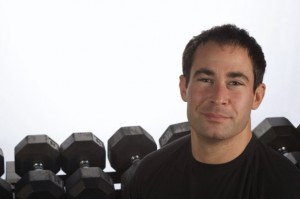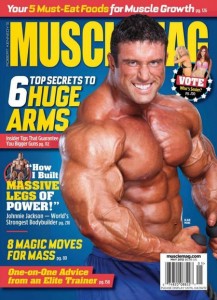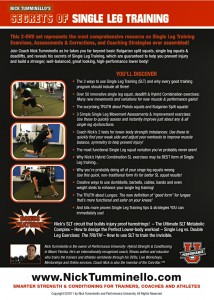
April 27, 2012
An Interview with Nick Tumminello
Nick Tumminello is not only an excellent trainer, he’s one of the real good guys in the fitness field. But what really impresses me about Nick – in addition to his innovative approach to training – is that he’s never afraid to speak his mind and challenge accepted dogma on a given fitness-related topic. You may remember that I interviewed Nick here a little over a year ago. Well, Nick has just come out with a new DVD on single leg training and it just so happens he has some interesting things to say on this subject and a few others. So without further ado, here’s the uncensored interview:
BJS: Musclemag recently featured you for your work with bodybuilders in this awesome 7 page spread. Congrats! How did this come about?

NT: I’m always grateful that I get to write articles for major fitness magazines. But, to have a major magazine do an article about me… man is that a huge professional honor! Especially in MuscleMag, which has been of one my favorite magazines since being teenager who was into lifting and trying to “get swole” 🙂
The article feature came about because I’ve been writing articles for several of the RKP magazines: Oxygen, Maximum Fitness, REPS! and MuscleMag. The editors of MuscleMag know me as a guy who’s always full of scientifically-inspired and athlete-approved ways to upgrade classic bodybuilding exercises. And, they are always interested in providing their readers with new ways to improve their workouts and bring about new muscle. So, when they decided they were going to start doing features of trainers, they contacted me to be the first. I’m so humbled that I was the very first name they thought of for this project.
MuscleMag filmed and photographed an extended training session I did with my friend and bodybuilder Fello Cambronero, who just won the OVERALL at the Sr. y Sra. musculo competition in Costa Rica. When it was all said and done, the editors liked the content so much they turned it into a BIG 7-page feature. I shared the excitment with Fello (Alex) Cambronero when the article was published because it was his first ever appreacnce in a major bodybuilding mag as a featured model. High five goes out to Alex and his lovely wife Maggy!
BJS: What’s your approach when working with bodybuilders? Specifically, do you use a mix of machines and free weights or do you prefer one versus the other. What about rep ranges?

NT: My approach with bodybuilders is to increase Hypertrophy, DUH! 🙂 That said, I still take a hybrid training approach with them. In that I incorporate mobility work, some 3D movements and even some athletic type drills into thier warm ups.
I absolutely use BOTH free weight and machines as they both have unique benefits the other doesn’t. Machines are actually a very consistent component in almost ALL of the bodybuilding workout programs I design because they allow for a constant tension on the muscles being worked, due to the Cam design of a machine. You don’t get that with free weights because they’re purely gravity dependant.
Just think about a Biceps curl with dumbbells; you get no resistance at the bottom (when your elbow is straight), and you don’t get much resistance at the top of the curl either because the lever arm is very short. Is that a bad thing?, NO! But, when doing biceps curls on machine, we can hit those angles gravity (i.e. free weights) wouldn’t allow.
This is why I don’t get caught up in these typical arguments over which is better, free weights or machines? We just do both because they both have benefits. And, we’ve found using them together get us results even faster because our workouts are more comprehensive.
For sets and reps: We use a variety of schemes. We’ll do basic 3-4 sets of 8-15 reps. We’ll do 4-6 sets of 4-6 reps. We love to alternate between those two basic rep schemes.
We’ll also use a wide variety of traditional and not so traditional overload concepts, such as: rest pauses, drop-sets, 21’s, 1.5 reps, etc. Along with many Performance U Hybrid Strength Training innovations such as 747s, Complexes, Triple Threat Protocols, 54321 workouts, etc.
BJS: Do you periodize bodybuilding routines or is it more intuitive?
NT: I always have some sort of plan. But, my “plans” are a moving target in that I’ll change something up a bit if needed.
One of my favorite, go-to bodybuilding program design strategies is to design a 6-week block program. In that 6-weeks your first (primary) exercise is alternated between two moves. The rest of the exercise in that workout stay the same for six weeks. But, the reps are undulated each workout. So, you have higher reps days, lower reps days, etc.
In short; We alternate and undulate! That’s my little saying, so I’ll know if anyone steals it 🙂
BJS: I know you have a new DVD on single leg training that was just released. What are the benefits of performing single limb exercise for the lower body?
![]()
NT: First, I’d like to say that just because I came out with a Single Leg Training DVD doesn’t mean I’m against double leg training. At Performance U, we use BOTH bilateral and unilateral lower-body training. This another situation where we don’t bother wasting our time arguing which is better because they both work!
When coaches and trainers stop being so concerned with being right over thier peers in these debates, and become more concerned with finding what right for thier clients in thier training, we’ll all be better off.
Anyway talk to most trainers about single leg training and they’ll likely show you pistol squats, single leg RDLs and Bulgarian split squats. Or, a small variations of those same basic movements. Those are great exercises, but they don’t even scratch the surface of what we’ve been able to do with our hybrid single leg training concepts and techniques. In other words, pistol squats, single leg RDLs and Bulgarian split squats are the checkers. But if you’re ready to play chess, get the Secrets of Single Leg DVD.
There are several benefits of single leg training that we’ve found:
Better balance: This one is obvious
Less Chance of Sports Injury – We hear lots about asymmetries and injury potential. But, the research I’ve seen says injury potential is more about strength asymmetries than anything else. In that, when you don’t control one side of your body as well as they other, you may be at a higher injury risk. Research shows us that you can still move a bit differently on each side (i.e. have a movement asymmetry), just as long as you can control the movement you can create on either side.
Better Body Control and Strength – By following the SAID principle (i.e. Specific Adaptations to Imposed Demands), if you want to make sure you’re strong and able to control each side of your body, you train each side of your body independently to ensure BOTH side can do what they need to.
Improved Muscle Symmetry – Not only will have better strength/control on both sides potentially help you minimize injury. It can help you look better and build a more symmetrical looking lower-body.
Improved Sports Performance – Sports require stops, starts, direction changes and raising and lowering your center of mass. And, most of the time these action are done from a split, unilateral type stance where one leg is positioned to do more work than the other. We’ve found Single leg training can help ensure that both legs can get the job done, regardless of the position you’re in!
Less risk of hurting yourself in the gym – A high percentage of humans have a leg length asymmetry, which would make double leg training more risky because your body is having to deal with torque (from the leg length issue) along with the compression from the load you’re lifting when squatting or deadlifting. Single leg work allows us to not worry as much about this issue potentially hurting our clients and athletes. Plus, it gives us more capacity to use heavy double leg training when we feel it appropriate.
BJS: If you could pick one single leg exercise that provides maximal benefits for muscle development, what would it be?

NT: When speaking purely about muscle development (for bodybuilding) purposes, I’d say the knee tap squat. It’s basically a single leg version of a front squat, with a bit more hip hinge to bring in more glutes and hams. It’s the exercise pictured in the middle images of the back of the DVD cover (see the image to the left).
BJS: You state that the pistol squat might not be a good exercise. Why?
NT: Here’s what I wrote for Laree Draper about this, which she posted here;
Although the pistol squat is a trendy, cool looking and old-time exercise, it’s not something we use with our clients and athletes at Performance U.
We don’t feel the pistol squat exercise is “bad”, nor do we feel it’s dangerous. And, we don’t get caught up arguing against Pistols, or will we try to convince anyone to stop doing them. All we can do is share the training methodologies that make the most sense to us, along with the exercise applications we’ve found to work best for us.
That said, in our training with individuals of all levels from pro athletes to active seniors, we haven’t found the body positions and force production patterns involved in the pistol squat exercise to have as much value and functional carryover as some of the other creative, hybrid single leg squat variations we use, which I’ve displayed in the Secrets of Single Leg Training 2-DVD set.
You can see more about why we don’t use the pistol squat in this video
embedded by Embedded Video
Sure the pistol squat can make you stronger! It’s also very challenging exercise. And, if you enjoy doing them, then great! But, we’ve found other single leg squat training options, which we’ve found to be more beneficial because they more accurately match the body postures we see in sports and daily living; and they more closely replicate the force production patterns we are looking to improve with the clients and athlete we train.
BJS: Many thanks for sharing your thoughts Nick!
You can check out Nick’s Blog at: NickTumminello.com
Here’s the link to check out Nick’s Secrets of Single Training DVD
4 Comments
RSS feed for comments on this post.
Sorry, the comment form is closed at this time.





 Entries (RSS)
Entries (RSS)




Nice interview, Nick.
Will check out your DVD. Looks interesting.
Comment by Anoop — April 30, 2012 @ 8:32 am
Very interesting interview Nick!
I like the ideas, especially about machines vs. free weights.
Comment by Dan Storren — May 3, 2012 @ 3:36 am
[…] Tumminello. An Interview with Nick Tumminello. Workout911. […]
Pingback by Ühepoolne vs kahepoolne jõutreening: võib-olla tuleks hinnata, kas kõige populaarsem on ka kõige efektiivsem « Risto Uuk — May 7, 2012 @ 6:15 am
Pro Hybrid Training Dvd Volume 3
[…] or bodybuilding mag as a featured model. High five goes out to Alex and his love […]
Trackback by Bemvu Blog — September 28, 2016 @ 8:49 pm